American popular music
This articleneeds additional citations forverification.(February 2022) |
| This article is part of a series on the |
| Music of the United States |
|---|
 |

American popular music(also referred to as "American Pop" ) ispopular musicproduced in theUnited Statesand is a part ofAmerican pop culture.Distinctive styles of American popular music emerged early in the 19th century, and in the 20th century the Americanmusic industrydeveloped a series of new forms of music, using elements of blues and othergenres.These popular styles included country, R&B, jazz and rock. The 1960s and 1970s saw a number of important changes in American popular music, including the development of a number of new styles, such asheavy metal,punk, soul, and hip hop.
American popular music is incredibly diverse, with styles includingragtime,blues,jazz,swing,rock,bluegrass,country,R&B,doo wop,gospel,soul,funk,pop,punk,disco,house,techno,salsa,grungeandhip hop.In addition, the American music industry is quite diverse, supporting a number of regional styles such aszydeco,klezmerandslack-key.Though these styles were not always in the sense ofmainstream,they were commercially recorded and therefore are examples ofpopular musicas opposed tofolkorclassical music.
American popular musical styles have had a significant influence onglobal culture.
Early popular music
[edit]
American folk singerPete Seegerdefined pop music as "professional music which draws upon both folk music and fine arts music".[1]Nineteenth century popular music mostly descended from earlier musical traditions such astheatre music,band music,dance music,andchurch music.[2]The earliest songs that could be consideredAmerican popular music,as opposed to the popular music of a particular region or ethnicity, were sentimentalparlor songsby Stephen Foster and his peers, and songs meant for use inminstrel shows,theatrical productions that featured singing, dancing and comic performances. Minstrel shows generally used African instruments anddance,and featured performers with their faces blackened, a technique calledblackface.[1]By the middle of the 19th century, touring companies had taken this music not only to every part of the United States, but also to the UK, Western Europe, and even to Africa and Asia. Minstrel shows were generally advertised as though the music of the shows was in anAfrican-American style,though this was often not true.[3]According to the historian of music, Larry Birnbaum, the music in minstrel shows was of mainly European origin, and was based onEnglish,Irish,andScottishfolk music.[4]Similarly the authorRichard Carlinstates that while minstrel shows used the banjo, an instrument of African origin, and popularized black culture, minstrel music was largely an amalgamation of European dance tunes.[5]Andrew Stott states that many of the songs that initiated the "craze for blackface" were of European origin.[6]

The first popular music published for private consumption in America came from Ireland in 1808 withThomas Moore'sIrish Melodies,a multi-volume book of mainly Irish folk songs arranged for private performances.[7]Inspired by Moore,John Hill Hewittbecame the first American songwriter to compose a style of popular music for private consumption, with his most famous piece "The Minstrels Return from War" becoming an international success.[7][8]Black people had taken part in American popular culture prior to the Civil War era, at least dating back to theAfrican Grove Theatrein New York in the 1820s and the publication of the first music by a black composer,Francis Johnson,in 1818. Centered inPhiladelphia,Johnson also led one of the first professional bands in American history from the 1820s to 1840s.[9]However, these important milestones still occurred entirely within the conventions of European music. Notable popular music in the 1830s and 1840s included publications byHenry Russelland theHutchinson Family.[10]
The first extremely popular minstrel song was "Jump Jim Crow"byThomas "Daddy" Rice,which was first performed in 1832 and was a sensation in London when Rice performed it there in 1836. Rice used a dance that he copied from a stable boy with a tune adopted from an Irishjig.Popular white performers of minstrel music includedGeorge Washington DixonandJoel Sweeneywhose tunes followed Scottish and Irish melodies.[11]The African elements included the use of thebanjo,believed to derive from West African string instruments, and accented and additive rhythms.[2]Beginning in 1843 theVirginia Minstrelsbecame the first group to popularize the minstrel show format, and by 1850 minstrel shows had spread across the entire United States.[11]
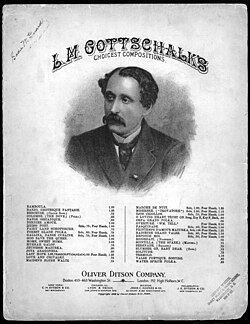
Many of the songs of the minstrel shows are still remembered today, especially those byDaniel EmmettandStephen Foster,the latter being, according to David Ewen, "America's first major composer, and one of the world's outstanding writers of songs".[3]Foster's songs were typical of the minstrel era in their unabashed sentimentality, and in their acceptance of slavery. Nevertheless, Foster did more than most songwriters of the period to humanize the blacks he composed about, such as in "Nelly Was a Lady", a plaintive, melancholy song about a black man mourning the loss of his wife.[4]In 1851 Foster's song "Old Folks at Home"would become a runaway national hit.[12]
The minstrel show marked the beginning of a long tradition of African-American music being appropriated for popular audiences, and was the first distinctly American form of music to find international acclaim, in the mid-19th century. As Donald Clarke has noted, minstrel shows contained "essentially black music, while the most successful acts were white, so that songs and dances of black origin were imitated by white performers and then taken up by black performers, who thus to some extent ended up imitating themselves". Clarke attributes the use of blackface to a desire for white Americans to glorify the brutal existence of both free and slave blacks by depicting them as happy and carefree individuals, best suited to plantation life and the performance of simple, joyous songs that easily appealed to white audiences.[5]It was only during theCivil Warthat white audiences first began to be exposed to genuine African-American music, first with the slavespiritualsGo Down, Mosesin 1861 and then through spiritual performances by thea capellagroup, theFisk Jubilee Singersin 1871.[4]After the Civil War minstrel shows performed by actual black troupes spread through the country and black composers such asJames A. Blandhad national success in the 1870s with songs such asCarry Me Back to Old VirginnyandOh, Dem Golden Slippers.[4][11]The post-Civil War period also saw the peak in popularity of professional band music, led by directors such asPatrick GilmoreandJohn Philip Sousa.[9]Sousa, known for his composition ofmilitary marches,achieved great fame in the United States and Europe with theUnited States Marine Band.[9]

Blackface minstrel shows remained popular throughout the last part of the 19th century, only gradually dying out near the beginning of the 20th century. During that time, a form of lavish and elaborate theater called theextravaganzaarose, beginning withCharles M. Barras'The Black Crook.[6]Extravaganzas were criticized by the newspapers and churches of the day because the shows were considered sexually titillating, with women singing bawdy songs dressed in nearly transparent clothing. David Ewen described this as the beginning of the "long and active careers in sex exploitation" of American musical theater and popular song.[7]Later, extravaganzas took elements ofburlesqueperformances, which were satiric and parodic productions that were very popular at the end of the 19th century.[8]
Like the extravaganza and the burlesque, the variety show was a comic and ribald production, popular from the middle to the end of the 19th century, at which time it had evolved intovaudeville.This form was innovated by producers likeTony Pastorwho tried to encourage women and children to attend his shows; they were hesitant because the theater had long been the domain of a rough and disorderly crowd.[9]By the early 20th century, vaudeville was a respected entertainment for women and children, and songwriters likeGus Edwardswrote songs that were popular across the country.[10]The most popular vaudeville shows were, like theZiegfeld Follies,a series of songs and skits that had a profound effect on the subsequent development ofBroadwaymusical theater and the songs ofTin Pan Alley.[13]
Tin Pan Alley
[edit]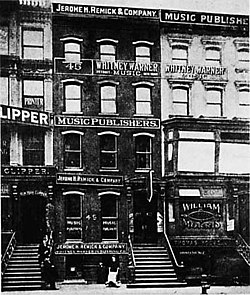
Tin Pan Alleywas an area on and surrounding West 28th Street.[14]in New York City, which became the major center for music publishing by the mid-1890s. The songwriters of this era wrote formulaic songs, many of them sentimental ballads.[11]During this era, a sense of national consciousness was developing, as the United States became a formidable world power, especially after theSpanish–American War.The increased availability and efficiency of railroads and the postal service helped disseminate ideas, including popular songs.[citation needed]
Some of the most notable publishers of Tin Pan Alley includedWillis Woodward,M. Witmark & Sons,Charles K. Harris,andEdward B. MarksandJoseph W. Stern.Stern and Marks were among the more well-known Tin Pan Alley songwriters; they began writing together as amateurs in 1894.[12]
In addition to the popular, mainstream ballads and other clean-cut songs, some Tin Pan Alley publishers focused on rough and risqué.Coon songswere another important part of Tin Pan Alley, derived from the watered-down songs of the minstrel show with the "verve and electricity" brought by the "assimilation of the ragtime rhythm".[13]The first popular coon songs were "The Dandy Coon's Parade" byJoseph P. Skellyin 1880 and "New Coon in Town", introduced in 1883 by J.S. Putnam, and these were followed by a wave ofcoon shouterslikeErnest HoganandMay Irwin.[4][14]Famous black composers of coon songs includedBert Williams,George W. JohnsonandIrving Jones.[15][4]Additionally the first time the word "rag"appears in sheet music is in reference to the instrumental accompaniment in Ernest Hogan's 1896 song" All Coons Look Alike to Me ", showing a connection between the two genres.[4]
Broadway
[edit]
The early 20th century also saw the growth ofBroadway,a group of theaters specializing inmusicals.Broadway became one of the preeminent locations for musical theater in the world, and produced a body of songs that led Donald Clarke to call the era, thegolden age of songwriting.The need to adapt enjoyable songs to the constraints of a theater and a plot enabled and encouraged growth in songwriting and the rise of composers likeGeorge Gershwin,Vincent Youmans,Irving BerlinandJerome Kern.[15]These songwriters wrote songs that have remained popular and are today known as theGreat American Songbook.[16]

Foreign operas were popular among the upper-class throughout the 19th century, while other styles of musical theater includedoperettas,ballad operasand theopera pouffe.The English operettas ofGilbert and Sullivanwere particularly popular, while American compositions had trouble finding an audience.George M. Cohanwas the first notable American composer of musical theater, and the first to move away from the operetta, and is also notable for using the language of the vernacular in his work. By the beginning of the 20th century, however, black playwrights, composers and musicians were having a profound effect on musical theater, beginning with the works ofWill Marion Cook,James Reese EuropeandJames P. Johnson;the first major hit black musical wasShuffle Alongin 1921.[16]
Imported operettas and domestic productions by both whites like Cohan and blacks like Cook, Europe and Johnson all had a formative influence on Broadway. Composers like Gershwin, Porter and Kern made comedic musical theater into a national pastime, with a feel that was distinctly American and not dependent on European models. Most of these individuals were Jewish, withCole Porterthe only major exception; they were the descendants of 19th century immigrants fleeing persecution in theRussian Empire,settled most influentially in various neighborhoods in New York City.[17]Many of the early musicals were influenced by black music, showing elements of early jazz, such asIn Dahomey;the Jewish composers of these works may have seen connections between the traditional African-Americanblue notesand their own folkJewish music.[17]
Broadway songs were recorded around the turn of the century, but did not become widely popular outside their theatrical context until much later. Jerome Kern's "They Didn't Believe Me"was an early song that became popular nationwide. Kern's later innovations included a more believable plot than the rather shapeless stories built around songs of earlier works, beginning withShow Boatin 1927. George Gershwin was perhaps the most influential composer on Broadway, beginning with "Swanee" in 1919 and later works for jazz and orchestras. His most enduring composition may be the operaPorgy and Bess,a story about two blacks, which Gershwin intended as a sort of "folk opera", a creation of a new style of American musical theater based on American idioms.[18]
Ragtime
[edit]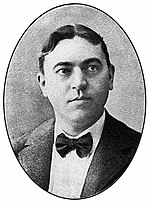
Ragtimewas a style ofdance musicbased around the piano, using syncopated rhythms andchromaticisms;[19]the genre's most well-known performer and composer was undoubtedlyScott Joplin.Donald Clarke considers ragtime the culmination ofcoon songs,used first inminstrel showsand thenvaudeville,and the result of the rhythms of minstrelsy percolating into the mainstream; he also suggests that ragtime's distinctive sound may have come from an attempt to imitate the African-American banjo using the keyboard.[20]According to musical historian,Elijah Wald,ragtime constitutes the first true pop genre in America, as earlier American music such as minstrel show music was distinguished by its association with blackface and comedy, rather than by having any unique style or sound.[18]
Due to the essentially African-American nature of ragtime, it is most commonly considered the first style of American popular music to be truly black music; ragtime brought syncopation and a more authentic black sound to popular music. Popular ragtime songs were notated and sold as sheet music, but the general style was played more informally across the nation; these amateur performers played a more free-flowing form of ragtime that eventually became a major formative influence onjazz.[21]
Early recorded popular music
[edit]
Thomas Edison's invention of thephonograph cylinderkicked off the birth of recorded music. The first cylinder to be released was "Semper Fidelis"by theU.S. Marine Band.At first, cylinders were released sparingly, but as their sales grew more profitable, distribution increased. These early recorded songs were a mix of vaudeville,barbershopquartets, marches, opera, novelty songs, and other popular tunes. Many popular standards, such as "The Good Old Summertime", "Shine On Harvest Moon",and" Over There "come from this time. There were also a few early hits in the field of jazz, beginning with theOriginal Dixieland Jazz Band's 1917 recordings, followed byKing Oliver's Creole Jazz Band,who played in a more authentic New Orleans jazz style.[22]
Blueshad beenaround a long timebefore it became a part of the first explosion of recorded popular music in American history. This came in the 1920s, whenclassic female bluessingers likeMa Rainey,Bessie SmithandMamie Smithgrew very popular; the first hit of this field was Mamie Smith's "Crazy Blues". These urban blues singers changed the idea ofpopular musicfrom being simple songs that could be easily performed by anyone to works primarily associated with an individual singer. Performers likeSophie Tucker,known for "Some of These Days", became closely associated with their hits, making their individualized interpretations just as important as the song itself.[23]
At the same time, record companies such asParamount RecordsandOKeh Recordslaunched the field ofrace music,which was mostly blues targeted at African-American audiences. The most famous of these acts went on to inspire much of the later popular development of the blues and blues-derived genres, includingCharley Patton,Lonnie JohnsonandRobert Johnson.[19]
Popular jazz (1920–1935) and swing (1935–1947)
[edit]This sectionneeds additional citations forverification.(March 2021) |
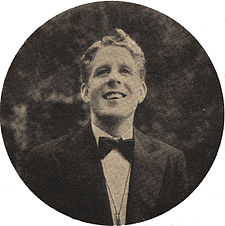
Jazzis a kind of music characterized byblue notes,syncopation,swing,call and response,polyrhythms,andimprovisation.Though originally a kind ofdance music,jazz has now been "long considered a kind of popular orvernacular music(and has also) become a sophisticated art form that has interacted in significant ways with themusic of the concert hall".[24]Jazz's development occurred at around the same time as modern ragtime, blues, gospel and country music, all of which can be seen as part of a continuum with no clear demarcation between them; jazz specifically was most closely related to ragtime, with which it could be distinguished by the use of more intricate rhythmic improvisation, often placing notes far from the implied beat. The earliest jazz bands adopted much of the vocabulary of the blues, including bent and blue notes and instrumental "growls" and smears.[citation needed]JazzartistRudy Valléebecame what was perhaps the first complete example of the 20th century mass mediapop star.[20]Vallée became the most prominent and, arguably, the first of a new style of popular singer, thecrooner.[20]
Paul Whitemanwas the most popular bandleader of the 1920s, and claimed for himself the title "The King of Jazz." Despite his hiring many of the other best white jazz musicians of the era, later generations of jazz lovers have often judged Whiteman's music to have little to do with real jazz. Nonetheless, his notion of combining jazz with elaborate orchestrations has been returned to repeatedly by composers and arrangers of later decades.[citation needed]

Whiteman commissioned Gershwin's "Rhapsody in Blue", which was debuted by Whiteman's Orchestra.Ted Lewis's band was second only to the Paul Whiteman in popularity during the 1920s, and arguably played more real jazz with less pretension than Whiteman, especially in his recordings of the late 1920s. Some of the other "jazz" bands of the decade included those of:Harry Reser,Leo Reisman,Abe Lyman,Nat Shilkret,George Olsen,Ben Bernie,Bob Haring,Ben Selvin,Earl Burtnett,Gus Arnheim,Rudy Vallee,Jean Goldkette,Isham Jones,Roger Wolfe Kahn,Sam Lanin,Vincent Lopez,Ben PollackandFred Waring.[21]

In the 1920s, the music performed by these artists was extremely popular with the public and was typically labeled as jazz. Today, however, this music is disparaged and labeled as "sweet music" by jazz purists. The music that people consider today as "jazz" tended to be played by minorities. In the 1920s and early 1930s, however, the majority of people listened to what we would call today "sweet music" and hardcore jazz was categorized as "hot music" or "race music."[citation needed]
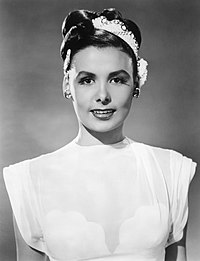
The largest and most influential recording label of the time, The Victor Talking Machine (RCA Victor after 1928) was a restraining influence on the development of "sweet jazz" until the departure ofEddie Kingin October 1926. King was well known as an authoritarian who would not permit drinking on the job or severe departure from the written music, unless within solos acceptable by popular music standards of the time. This irritated many Victor jazz artists, including famed trumpeter Bix Beiderbecke. Sudhalter, in Lost Chords, cites an example of a 1927 recording by the Goldkette Orchestra in which musicians were allowed considerable freedom, and remarks "What, one wonders, would this performance have been if Eddie King had been in charge, and not the more liberal Nat Shilkret. Since the Victor ledgers show no less than five recording sessions in January and February 1926, when King actually conducted Goldkette's Orchestra, comparison between the approach of Goldkette and King is readily available.[citation needed]
An early genre of American pop music was theswingcraze, a popular dance style in the early part of the 20th century.[22]In 1935,swing musicbecame popular with the public and quickly replaced jazz as the most popular type of music (although there was some resistance to it at first). Swing music is characterized by a strong rhythm section, usually consisting of a double bass and drums, playing in a medium to fasttempo,and rhythmic devices such as theswung note.Swing is primarily a kind of 1930s jazz fused with elements of the blues and the pop sensibility of Tin Pan Alley.[25]Swing usedbigger bandsthan other kinds of jazz had and was headed by bandleaders that tightly arranged the material, discouraging the improvisation that had been an integral part of jazz. David Clarke called swing the first "jazz-oriented style (to be) at the center of popular music... as opposed to merely giving it backbone".[26]By the end of the 1930s, vocalists became more and more prominent, eventually taking center stage following theAmerican Federation of Musiciansstrike, which made recording with a large band prohibitively expensive.[27]Swing came to be accompanied by a popular dance called theswing dance,which was very popular across the United States, among both white and black audiences, especially youth.[citation needed]
Blues diversification and popularization
[edit]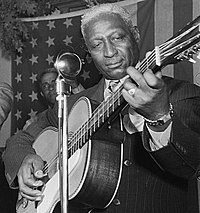
In addition to the popular jazz and swing music listened to by mainstream America, there were a number of other genres that were popular among certain groups of people—e.g., minorities or rural audiences. Beginning in the 1920s and accelerating greatly in the 1940s, the blues began rapidly diversifying into a broad spectrum of new styles. These included an uptempo, energetic style calledrhythm and blues(R&B), a merger of blues and Anglo-Celtic song calledcountry musicand the fusion ofhymnsandspiritualswith blues structures calledgospel music.Later than these other styles, in the 1940s, a blues, R&B and country fusion eventually calledrock and rolldeveloped, eventually coming to dominate American popular music by the beginning of the 1960s.[citation needed]
Country music is primarily a fusion of African-American blues and spirituals withAppalachian folk music,adapted for pop audiences and popularized beginning in the 1920s. Of particular importance was Irish and Scottish tunes, dance music, balladry and vocal styles,[28]as well asNative American,Spanish,German,FrenchandMexicanmusic. The instrumentation of early country revolved around the European-derivedfiddleand the African-derivedbanjo,with the guitar added later. Country music instrumentation used African elements including a call-and-response format, improvised music andsyncopatedrhythms. Later still, string instruments such as theukuleleandsteel guitarbecame commonplace due to the popularity ofHawaiian musicin the early 20th century and the influence of musicians such asSol HoʻopiʻiandLani McIntyre.[29]The roots of modern country music are generally traced to 1927, when music talent scoutRalph PeerrecordedJimmie RodgersandThe Carter Family.Their recordings are considered the foundation for modern country music. There had been popular music prior to 1927 that could be considered country, but, as Ace Collins points out, these recordings had "only marginal and very inconsistent" effects on the national music markets, and were only superficially similar to what was then known ashillbilly music.[30]In addition to Rodgers and the Carters, a musician namedBob Willswas an influential early performer known for a style calledWestern swing,which was very popular in the 1920s and 30s, and was responsible for bringing a prominent jazz influence to country music.[citation needed]

Rhythm and blues (R&B) is a style that arose in the 1930s and 1940s, a rhythmic and uptempo form of blues with more complex instrumentation. Author Amiri Baraka described early R&B as "huge rhythm units smashing away behind screaming blues singers (who) had to shout to be heard above the clanging and strumming of the various electrified instruments and the churning rhythm sections.[31].R&B was recorded during this period, but not extensively, and it was not widely promoted by record companies that felt it was not suited for most audiences, especially middle-class whites, because of the suggestive lyrics and driving rhythms.[32]Bandleaders likeLouis Jordaninnovated the sound of early R&B. Jordan's band featured a small horn section and prominent rhythm instrumentation and used songs with bluesy lyrical themes. By the end of the 1940s, he had produced nineteen major hits, and helped pave the way for contemporaries includingWynonie Harris,John Lee HookerandRoy Milton.[citation needed]
Christian spirituals and rural blues music were the origin of what is now known as gospel music. Beginning in about the 1920s, African-American churches featured early gospel in the form of worshipers proclaiming their religious devotion (testifying) in an improvised, often musical manner. Modern gospel began with the work of composers, most importantlyThomas A. Dorsey,who "(composed) songs based on familiar spirituals and hymns, fused to blues and jazz rhythms".[33]From these early 20th-century churches, gospel music spread across the country. It remained associated almost entirely with African-American churches, and usually featured a choir along with one or more virtuoso soloists.[citation needed]
Rock and roll is a kind of popular music, developed primarily out of country, blues and R&B. Easily the single most popular style of music worldwide,rock's exact origins and early developmenthave been hotly debated. Music historian Robert Palmer has noted that the style's influences are quite diverse, and include theAfro-Caribbean"Bo Diddleybeat ", elements of" big band swing "andLatin musiclike the Cubansonand "Mexican rhythms".[34]Another author, George Lipsitz claims that rock arose in America's urban areas, where there formed a "polyglot,working-class culture(where the) social meanings previously conveyed in isolation by blues, country,polka,zydecoand Latin music found new expression as they blended in an urban environment ".[35]
1950s and 1960s
[edit]This sectionneeds additional citations forverification.(February 2022) |
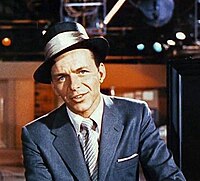
The middle of the 20th century saw a number of very important changes in American popular music. The field of pop music developed tremendously during this period, as the increasingly low price of recorded music stimulated demand and greater profits for the record industry. As a result, music marketing became more and more prominent, resulting in a number of mainstream pop stars whose popularity was previously unheard of. Many of the first such stars were Italian-American crooners likeDean Martin,Rudy Vallee,Tony Bennett,Perry Como,Frankie Laineand, most famously, the "first pop vocalist to engender hysteria among his fans"Frank Sinatra.[36]One of the most successful crooners wasBing Crosby.Crosby cited popular singerAl Jolsonas one of his main influences. Crosby was in turn cited byPerry Como.[23]Crosby also influenced this singing ofFrank Sinatra,[24]Crosby and Sinatra sung together in the 1956 filmHigh Society.[25]

The era of the modern teen pop star, however, began in the 1960s. American pop musical examples from the 1960s includeThe Monkees.[26]Bubblegum popgroups likeThe Monkeeswere chosen entirely for their appearance and ability to sell records, with less regard to musical ability. The same period, however, also saw the rise of new forms of pop music that achieved a more permanent presence in the field of American popular music, including rock, soul and pop-folk. By the end of the 1960s, two developments had completely changed popular music: the birth of acounterculture,which explicitly opposed mainstream music, often in tandem with political and social activism, and the shift from professional composers to performers who were bothsingers and songwriters.[citation needed]
Rock and roll first entered mainstream popular music through a style calledrockabilly,which fused the nascent rock sound with elements of country music. Black-performed rock and roll previously had limited mainstream success, and some observers at the time believed that a white performer who could credibly sing in an R&B and country style would be a success.Sam Phillips,ofMemphis, Tennessee'sSun Records,found such a performer inElvis Presley,who became one of the best-selling musicians in history, and brought rock and roll to audiences across the world.[37]Presley's success was preceded byBill Haley,a white performer whose "Rock Around the Clock"is sometimes pointed to as the start of the rock era. However, Haley's music was" more arranged "and" more calculated "than the" looser rhythms "of rockabilly, which also, unlike Haley, did not use saxophones or chorus singing.[38]

R&B remained extremely popular during the 1950s among black audiences, but the style was not considered appropriate for whites, or respectable middle-class blacks, because of its suggestive nature. Many popular R&B songs instead were performed by white musicians likePat Boone,in a more palatable, mainstream style, and turned into pop hits.[39]By the end of the 1950s, however, there was a wave of popular black blues-rock and country-influenced R&B performers gaining unprecedented fame among white listeners; these includedBo DiddleyandChuck Berry.[40]Over time, producers in the R&B field gradually turned to more rock-based acts likeLittle RichardandFats Domino.[27]

Doo wop is a kind of vocal harmony music performed by groups who became popular in the 1950s.[28]Though sometimes considered a kind of rock, doo wop is more precisely a fusion of vocal R&B, gospel and jazz with the blues and pop structures,[41]though until the 1960s, the lines separating rock from doo wop, R&B and other related styles were very blurry. Doo wop became the first style of R&B-derived music "to take shape, to define itself as something people recognized as new, different, strange,theirs"(emphasis in original).[42]As doo wop grew more popular, more innovations were added, including the use of a bass lead vocalist, a practice that began withJimmy RicksofThe Ravens.[43]Doo wop performers were originally almost all black, but a few white and integrated groups soon became popular. These included a number of Italian-American groups such asDion & the Belmonts,while others added female vocalists and even formed all-female groups in the nearly universally male field; these includedThe QueensandThe Chantels.[44]
The 1950s saw a number of brief fads that went on to have a great impact on future styles of music. Performers such asPete SeegerandThe Weaverspopularized a form ofold-time revivalofAnglo-American music.[45]This field eventually became associated with the political left-wing andCommunism,leading to a decline in acceptability as artists were increasinglyblacklistedand criticized. Nevertheless, this form of pop-folk exerted a profound influence in the form of 1950sfolk-rockand related styles. Alongside the rather sporadic success of popularized Anglo folk music came a series ofLatin dancefads, includingmambo,rumba,chachacháandboogaloo.Though their success was again sporadic and brief, Latin music continued to exert a continuous influence on rock, soul and other styles, as well as eventually evolving intosalsa musicin the 1970s.[citation needed]
Country: Nashville Sound
[edit]
Beginning in the late 1920s, a distinctive style first called "old-timey" or "hillbilly" music began to be broadcast and recorded in the rural South and Midwest; early artists included the Carter Family, Charlie Poole and his North Carolina Ramblers, and Jimmie Rodgers. The performance and dissemination of this music was regional at first, but the population shifts caused by World War II spread it more widely. After the war, there was increased interest in specialty styles, including what had been known asraceandhillbillymusic; these styles were renamed torhythm and bluesandcountry and western,respectively.[46]Major labels had some success promoting two kinds of country acts: Southernnoveltyperformers likeTex Williamsand singers likeFrankie Laine,who mixed pop and country in a conventionally sentimental style.[29]This period also saw the rise ofHank Williams,[30]a white country singer who had learned the blues from a black street musician named Tee-Tot, in northwest Alabama.[47]Before his death in 1953, Hank Williams recorded eleven singles that sold at least a million copies each and pioneered theNashville sound.[citation needed]

The Nashville sound was a popular kind of country music that arose in the 1950s, a fusion of popularbig bandjazz andswingwith the lyricism of honky-tonk country.[48]The popular success of Hank Williams' recordings had convinced record labels that country music could find mainstream audiences. Record companies then tried to strip the rough, honky-tonk elements from country music, removing the unapologetically rural sound that had made Williams famous. Nashville's industry was reacting to the rise ofrockabillyperformer Elvis Presley by marketing performers that crossed the divide between country and pop.[31]Chet Atkins,[32]head ofRCA's country music division, did the most to innovate the Nashville sound by abandoning the rougher elements of country, whileOwen Bradleyused sophisticated production techniques and smooth instrumentation that eventually became standard in the Nashville Sound, which also grew to incorporate strings and vocal choirs.[33]By the early part of the 1960s, the Nashville sound was perceived as watered-down by many more traditionalist performers and fans, resulting in a number of local scenes like theLubbock soundand, most influentially, theBakersfield sound.[citation needed]
Throughout the 1950s, the most popular kind of country music was the Nashville Sound, which was a slick and pop-oriented style. Many musicians preferred a rougher sound, leading to the development of theLubbock SoundandBakersfield Sound.The Bakersfield Sound was innovated inBakersfield, Californiain the mid to late 1950s, by performers likeWynn Stewart,who used elements ofWestern swingand rock, such as thebreakbeat,along with a honky tonk vocal style.[49]He was followed by a wave of performers, among themBuck OwensandMerle Haggard,who popularized the style.[citation needed]
Soul
[edit]
Soul music is a combination of R&B and gospel that began in the late 1950s in the United States. Soul music is characterized by its use of gospel techniques with a greater emphasis on vocalists, and the use of secular themes. The 1950s recordings ofSam Cooke,Ray Charles,[34]andJames Brownare commonly considered the beginnings of soul music.Solomon Burke's early recordings for Atlantic Records codified the style, and as Peter Guralnick writes, "it was only with the coming together of Burke and Atlantic Records that you could see anything resembling a movement".[50]
TheMotown Record Corporationin Detroit, Michigan became successful with a string of heavily pop-influenced soul records, which were palatable enough to white listeners so as to allow R&B and soul to crossover to mainstream audiences.[35]An important center of soul music recording wasFlorence,Alabama, where theFAME Studiosoperated.Jimmy Hughes,Percy SledgeandArthur Alexanderrecorded at Fame; later in the 1960s,Aretha Franklinwould also record in the area. Fame Studios, often referred to asMuscle Shoals,after a town neighboring Florence, enjoyed a close relationship with Stax, and many of the musicians and producers who worked in Memphis also contributed to recordings done in Alabama.[citation needed]
In Memphis,Stax Recordsproduced recordings by soul pioneersOtis Redding,Wilson Pickett,[36]andDon Covay.Other Stax artists such asEddie FloydandJohnnie Tayloralso made significant contributions to soul music. By 1968, the soul music movement had begun to splinter, as James Brown andSly & the Family Stonebegan to expand upon and abstract both soul and rhythm and blues into other forms. Guralnick wrote that more "than anything else... what seems to me to have brought the era of soul to a grinding, unsettling halt was the death of Martin Luther King in April 1968".[51]
1960s rock
[edit]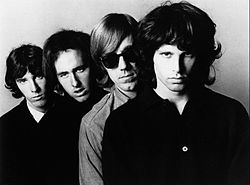
Among the first of the major new rock genres of the 1960s wassurf,pioneered by CalifornianDick Dale.Surf was largely instrumental and guitar-based rock with a distorted and twanging sound, and was associated with theSouthern Californiasurfing-basedyouth culture.Dale had worked withLeo Fender,developing the "Showman amplifierand... the reverberation unit that would give surf music its distinctively fuzzy sound ".[52]
Inspired by the lyrical focus of surf, if not the musical basis,The Beach Boysbegan their career in 1961 with a string of hits like "Surfin' U.S.A.".Their sound was not instrumental, nor guitar-based, but was full of" rich, dense and unquestionably special "" floating vocals (with)Four Freshman-ish harmonies riding over a droned, propulsive burden ".[53]The Beach Boys' songwriterBrian Wilsongrew gradually more eccentric, experimenting with new studio techniques as he became associated with the burgeoningcounterculture.[37]
The counterculture was a youth movement that included political activism, especially in opposition to the Vietnam War, and the promotion of varioushippieideals. The hippies were associated primarily with two kinds of music: thefolk-rockandcountry rockof people likeBob DylanandGram Parsons,and thepsychedelic rockof bands likeJefferson AirplaneandThe Doors.[38]This movement was very closely connected to theBritish Invasion,a wave of bands from the United Kingdom who became popular throughout much of the 1960s. The British Invasion initially included bands such asthe Beatles,theRolling Stones,[39]andThe Zombieswho were later joined by bands like theMoody BluesandThe Who.[40]The sound of these bands was hard-edged rock, with the Beatles originally known for songs that resembled classic black rock songs byLittle Richard,Chuck Berry,Smokey Robinson,The Shirellesand theIsley Brothers.[54]Later, as the counterculture developed, The Beatles began using more advanced techniques and unusual instruments, such as thesitar,as well as more original lyrics.[41]

Folk-rock drew on the sporadic mainstream success of groups like theKingston Trioand theAlmanac Singers,whileWoody GuthrieandPete Seegerhelped to politically radicalize rural white folk music.[55]The popular musicianBob Dylanrose to prominence in the middle of the 1960s, fusing folk with rock and making the nascent scene closely connected to theCivil Rights Movement.He was followed by a number of country-rock bands likeThe Byrdsand theFlying Burrito Brothersand folk-oriented singer-songwriters likeJoan Baezand the CanadianJoni Mitchell.However, by the end of the decade, there was little political or social awareness evident in the lyrics of pop-singer-songwriters likeJames TaylorandCarole King,whose self-penned songs were deeply personal and emotional.[citation needed]
Psychedelic rock was a hard, driving kind of guitar-based rock, closely associated with the city of San Francisco, California. Though Jefferson Airplane was the only psychedelic San Francisco band to have a major national hit, with 1967's "Somebody to Love" and "White Rabbit", theGrateful Dead,a folk, country and bluegrass-flavoredjam band,"embodied all the elements of the San Francisco scene and came... to represent the counterculture to the rest of the country"; the Grateful Dead also became known for introducing the counterculture, and the rest of the country, to the ideas of people likeTimothy Leary,especially the use of hallucinogenic drugs includingLSDfor spiritual and philosophical purposes.[56]
1970s and 1980s
[edit]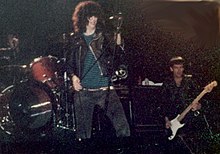
Following the turbulent political, social and musical changes of the 1960s and early 1970s, rock music diversified. What was formerly known asrock and roll,a reasonably discrete style of music, had evolved into a catchall category called simplyrock music,an umbrella term which would eventually include diverse styles likeheavy metal music,punk rockand, sometimes evenhip hop music.During the 1970s, however, most of these styles were not part of mainstream music, and were evolving in the underground music scene.[citation needed]
The early 1970s saw a wave of singer-songwriters who drew on the introspective, deeply emotional and personal lyrics of 1960s folk-rock. They includedJames Taylor,Carole Kingand others, all known just as much for their lyric ability as for their performances. The same period saw the rise of bluesySouthern rockandcountry rockgroups like theAllman Brothers BandandLynyrd Skynyrd.[57]In the 1970s,soft rockdeveloped, a kind of simple, unobtrusive and mellow form of pop-rock, exemplified by a number of bands likeAmericaandBread,most of whom are little remembered today; many wereone-hit wonders.[58]In addition, harderarena rockbands likeChicagoandStyxalso saw some major success.[citation needed]

The early 1970s saw the rise of a new style of country music that was as rough and hard-edged, and which quickly became the most popular form of country. This wasoutlaw country,a style that included such mainstream stars asWillie NelsonandWaylon Jennings.[59]Outlaw country was very rock-oriented, and had lyrics that focused on the criminal, especially drug and alcohol-related, antics of its performers, who grew their hair long, wore denim and leather and looked like hippies in contrast to the clean-cut country singers that were pushing the Nashville sound.[60]
By the mid-1970s,disco,a form of dance music, was becoming popular, evolving from underground dance clubs to mainstream America. Disco reached its zenith following the release ofSaturday Night Feverand the phenomenon surrounding the movie and the soundtrack byThe Bee Gees.Disco's time was short, however, and by 1980 was soon replaced with a number of genres that evolved out of thepunk rockscene, likenew wave.Bruce Springsteenbecame a major star, first in the mid to late 1970s and then throughout the 1980s, with dense, inscrutable lyrics and anthemic songs that resonated with the middle and lower classes.[61]
1970s funk and soul
[edit]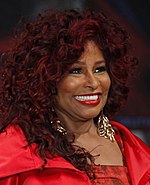
In the early 1970s, soul music was influenced by psychedelic rock and other styles. The social and political ferment of the times inspired artists likeMarvin GayeandCurtis Mayfieldto release album-length statements with hard-hitting social commentary. Artists like James Brown led soul towards more dance-oriented music, which eventually evolved intofunk.Funk was typified by 1970s bands likeParliament-Funkadelic,The Meters,and James Brown himself, while more versatile groups likeWar,The CommodoresandEarth, Wind and Firealso became popular. During the 1970s, some highly slick and commercialblue-eyed soulacts like Philadelphia'sHall & Oatesachieved mainstream success, as well as a new generation of street-corner harmony or city-soul groups likeThe Delfonicsand Howard University'sUnifics.[citation needed]
By the end of the 1970s, Philly soul, funk, rock and most other genres were dominated by disco-inflected tracks. During this period, funk bands likeThe O'JaysandThe Spinnerscontinued to turn out hits. After the death of disco in 1980, soul music survived for a short time before going through yet another metamorphosis. With the introduction of influences fromelectro musicand funk, soul music became less raw and more slickly produced, resulting in a genre of music that was again calledR&B,usually distinguished from the earlier rhythm and blues by identifying it ascontemporary R&B.[citation needed]
1980s pop
[edit]
By the 1960s, the termrhythm and blueshad no longer been in wide use; instead, terms such assoul musicwere used to describe popular music by black artists. In the 1980s, however,rhythm and bluescame back into use, most often in the form ofR&B,a usage that has continued to the present. Contemporary R&B arose when sultry funk singers likePrincebecame very popular, alongside dance-oriented pop stars likeMichael JacksonandMadonna.[62]
By the end of the 1980s, pop-rock largely consisted of the radio-friendlyglam metalbands, who used images derived from the Britishglammovement with macho lyrics and attitudes, accompanied byhard rockmusic and heavy metal virtuosic soloing. Bands from this era included many British groups likeDef Leppard,as well as heavy metal-influenced American bandsMötley Crüe,Guns N' Roses,Bon JoviandVan Halen.[63]
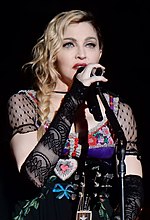
The mid-1980s also sawGospel musicsee its popularity peak. A new form of gospel had evolved, calledContemporary Christian music(CCM). CCM had been around since the late 1960s, and consisted of a pop/rock sound with slight religious lyrics. CCM had become the most popular form of gospel by the mid-1980s, especially with artists likeAmy Grant,Michael W. Smith,andKathy Troccoli.Amy Grant was the most popular CCM, and gospel, singer of the 1980s, and after experiencing unprecedented success in CCM, crossed over into mainstream pop in the 1980s and 1990s. Michael W. Smith also had considerable success in CCM before crossing over to a successful career in pop music as well. Grant would later produce CCM's first No. 1 pop hit ( "Baby Baby" ), and CCM's best-selling album (Heart in Motion).[citation needed]
In the 1980s, the country music charts were dominated by pop singers with only tangential influences from country music, a trend that has continued since. The 1980s saw a revival of honky-tonk-style country with the rise of people likeDwight Yoakamand thenew traditionalistsEmmylou HarrisandRicky Skaggs,[64]as well as the development ofalternative countryperformers likeUncle Tupelo.Later alternative country performers, likeWhiskeytown'sRyan AdamsandWilco,found some mainstream success.[citation needed]
Birth of the underground
[edit]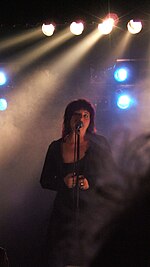
During the 1970s, a number of diverse styles emerged in stark contrast to mainstream American popular music. Though these genres were not largely popular in the sense of selling many records to mainstream audiences, they were examples ofpopular music,as opposed tofolkorclassical music.In the early 1970s, African Americans and Puerto Ricans in New York City developedhip hop culture,which produced a style of music also calledhip hop.At roughly the same time, Latinos, especially Cubans and Puerto Ricans, in New York also innovatedsalsa music,which combined many forms of Latin music with R&B and rock. The genres ofpunk rockandheavy metalwere most closely associated with the United Kingdom in the 1970s, while various American derivatives evolved later in the decade and into the 1980s. Meanwhile, Detroit slowly evolved a series ofelectronic musicgenres likehouseandtechnothat later became a major part of popular music worldwide.[citation needed]
Hip hop
[edit]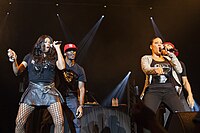
Hip hopis a cultural movement, of which music is a part, along withgraffitiandbreakdancing.The music is composed of two parts,rapping,the delivery of swift, highly rhythmic and lyrical vocals, and DJing, the production of instrumentation either throughsampling,instrumentation,turntablismorbeatboxing.[65]Hip hop arose in the early 1970s inThe Bronx,New York City. Jamaican immigrantDJ Kool Hercis widely regarded as the progenitor of hip hop; he brought with him the practice oftoastingover the rhythms of popular songs. In New York, DJs like Kool Herc played records of popular funk, disco and rock songs. Emcees originally arose to introduce the songs and keep the crowd excited and dancing; over time, the DJs began isolating the percussion breaks (the rhythmic climax of songs), thus producing a repeated beat that the emcees rapped over.[citation needed]
Rapping included greetings to friends and enemies, exhortations to dance and colorful, often humorous boasts. By the beginning of the 1980s, there had been popular hip-hop songs like "Rappers Delight"by theSugarhill Gangand a few major celebrities of the scene, such asLL Cool JandKurtis Blow.Other performers experimented with politicized lyrics and social awareness, while others performed fusions withjazz,heavy metal,techno,funkandsoul.Hip hop began to diversify in the latter part of the 1980s. New styles appeared, likealternative hip hopand the closely relatedjazz rapfusion, pioneered by such rappers asDe La SoulandGuru.The crewsPublic EnemyandN.W.Adid the most during this era to bring hip hop to national attention; the former did so with incendiary and politically charged lyrics, while the latter became the first prominent example ofgangsta rap.[citation needed]
Salsa
[edit]
Salsa music is a diverse and predominantlyCaribbeanrhythm that is popular in manyLatin Americancountries. Salsa incorporates multiple styles and variations; the term can be used to describe most any form of the popular Cuban-derivedmusical genres(likechachacháandmambo). Most specifically however,salsarefers to a particular style developed by mid-1970s groups of New York City-area Cuban andPuerto Ricanimmigrants to the United States, and stylistic descendants like 1980ssalsa romantica.[66]
Salsa music always has a 4/4meter.The music is phrased in groups of two bars, using recurring rhythmic patterns, and the beginning of phrases in the song text and instruments. Typically, the rhythmic patterns played on the percussion are rather complicated, often with several different patterns played simultaneously. Theclave rhythmis an important element that forms the basis of salsa. Apart from percussion, a variety of melodic instruments are commonly used as accompaniment, such as a guitar, trumpets, trombones, the piano, and many others, all depending on the performing artists. Bands are typically divided into horn and rhythm sections, led by one or more singers (sonerosorsalseros).[67]
Punk and alternative rock
[edit]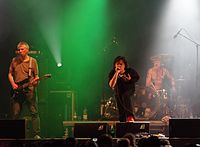
Punk was a kind of rebellious rock music that began in the 1970s as a reaction against the popular music of the day – especiallydisco,which was seen as insipid and uninspired. Punk drew on American bands including theVelvet Underground,The Stoogesand theNew York Dolls.[68]Punk was loud, aggressive and usually very simple, requiring little musical training to play. Later in the decade, British bands including theSex PistolsandThe Clashenjoyed substantial fame at home and, to a lesser degree, in the United States. American bands in the field included most famouslyThe Ramones,as well as groups likeTalking Headsthat played a more artsy kind of music that was closely associated with punk before eventually evolving into pop-new wave.[69]Other major acts includeBlondie,Patti SmithandTelevision.Most of these bands got their start at what is considered "ground zero"[42]of punk rock, a club named CBGB. The small club in New York threw a festival in 1975 that showed off the "top 40 unrecorded rock bands". Among these bands were the previously mentionedThe Ramones,Sex Pistols,Blondieand the like.[citation needed]
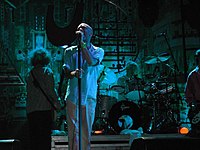
Hardcore punkwas the response of American youths to the worldwidepunk rockexplosion of the late 1970s. Hardcore stripped punk rock and New Wave of its sometimes elitist and artsy tendencies, resulting in short, fast, and intense songs that spoke to disaffected youth. Hardcore exploded in the American metropolises of Los Angeles, Washington, D.C., New York andBostonand most American cities had their own local scenes by the end of the 1980s.[70]
Alternative rockis a diverse grouping of rock bands that in America developed largely from the hardcore scene in the 1980s in stark opposition to the mainstream music scene. Alternative rock subgenres that developed during the decade includeindie rock,Gothic rock,noise rock,grunge,andcollege rock.Most alternative bands were unified by their collective debt to punk, which laid the groundwork for underground and alternative music in the 1970s. Though the genre is considered to be rock, some styles were influenced by American folk,reggaeand jazz. Like punk and hardcore, alternative rock had little mainstream success in America in the 1980s, but via the grassroots establishment of anindiescene through touring,college radio,fanzines, and word-of-mouth, alternative bands laid the groundwork for the breakthrough of the genre in the American public consciousness in the next decade.[citation needed]
Heavy metal
[edit]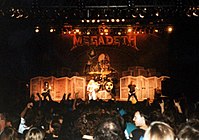
Heavy metal is a form of music characterized by aggressive, driving rhythms and highly amplified distorted guitars, generally with grandiose lyrics and virtuosic instrumentation. Heavy metal is a development of blues,blues rock,rock and prog rock. Its origins lie in the British hard rock bands who between 1967 and 1974 took blues and rock and created a hybrid with a heavy, guitar-and-drums-centered sound. Most of the pioneers in the field, likeBlack Sabbath,were English, though many were inspired by American performers likeBlue CheerandJimi Hendrix.[citation needed]
In the early 1970s, the first major American bands began appearing, likeBlue Öyster CultandAerosmith,and musicians likeEddie Van Halenbegan their career. Heavy metal remained, however, a largely underground phenomenon. During the 1980s, a pop-based form of hard rock, with a party-hearty spirit and a glam-influenced visual aesthetic (sometimes referred to as "hair metal" ) dominated the music charts, led by superstars likePoison,Bon Jovi,Mötley Crüe,andRatt.The 1987 debut ofGuns N' Roses,a hard rock band whose image reflected the grittier underbelly of the Sunset Strip, was at least in part a reaction against the overly polished image of hair metal, but that band's wild success was in many ways the last gasp of the hard-rock and metal scene. By the mid-1980s, as the term "heavy metal" became the subject of much contestation, the style had branched out in so many different directions that new classifications were created by fans, record companies, and fanzines, although sometimes the differences between various subgenres were unclear, even to the artists purportedly belonging to a given style. The most notable of the 1980s metal subgenres in the United States was the swift and aggressivethrash metalstyle, pioneered by bands likeAnthrax,Megadeth,Metallica,andSlayer.[citation needed]
1990s
[edit]
Perhaps the most important change in the 1990s in American popular music was the rise ofalternative rockthrough the popularity ofgrunge.This was previously an explicitly anti-mainstream grouping of genres that rose to great fame beginning in the early 1990s. The genre in its early stages was largely situated onSub Pop Records,a company founded byBruce Pavitt and John Poneman.Significant grunge bands signed to the label wereGreen River(half of the members from this band would later become founding members ofPearl Jam),Sonic Youth(although not a grunge band they were influential on grunge bands and in fact it was upon the insistence ofKim Gordonthat theDavid Geffen CompanysignedNirvana) and Nirvana. Grunge is an alternative rock subgenre with a "dark, brooding guitar-based sludge" sound,[71]drawing on heavy metal, punk, and elements of bands like Sonic Youth and their use of "unconventional tunings to bend otherwise standard pop songs completely out of shape."[72]With the addition of a "melodic, Beatlesque element" to the sound of bands like Nirvana, grunge became wildly popular across the United States.
[73]Grunge became commercially successful in the early 1990s, peaking between 1991 and 1994. Bands from cities in the U.S.Pacific NorthwestespeciallySeattle,Washington, were responsible for creating grunge and later made it popular with mainstream audiences. The supposedGeneration X,who had just reached adulthood as grunge's popularity peaked, were closely associated with grunge, the sound which helped "define the desperation of (that) generation."[74]Bands such asFoo FightersandCreedbecame a form of alternative rock known as post-grunge, popular because it was radio friendly unlike the grunge bands by which they were musically influenced.Pop punkbands likeGreen DayandBlink 182also gained popularity. In the second half of the 1990snu metalarose with bands such asLinkin Park,Korn,Limp BizkitandSlipknot.The independent culture slumbered in the underground scenes with new genres such aslo-fi(Beck,Sparklehorse,Guided By Voices),math rock(Slint,Shellac) andpost-rock(Explosions in the Sky,Tortoise).EmocoreandPost-hardcorebecame more known with bands such asAt the Drive-InandFugazi.[citation needed]
Gangsta rapis a kind of hip hop, most importantly characterized by a lyrical focus on macho sexuality, physicality and a dangerous, criminal image. Though the origins of gangsta rap can be traced back to the mid-1980s raps of Philadelphia'sSchoolly Dand theWest Coast'sIce-T,the style is usually said to have begun in the Los Angeles and Oakland area, whereToo Short,N.W.Aand others found their fame. ThisWest Coast rapscene spawned the early 1990sG-funksound, which paired gangsta rap lyrics with a thick and hazy tone, often relying on samples from 1970sP-funk;the best-known proponents of this sound were the breakthrough rappersDr. DreandSnoop Dogg.[citation needed]
2000s
[edit]
By the end of the 1990s and into the early 2000s pop music consisted mostly of a combination of pop-hip hop and R&B-tinged pop, including a number of boy bands. Notable female singers also cemented their status in American and worldwide popular music, such asBeyoncé(with her solo career and as lead singer ofDestiny's Child),Britney Spears,Christina Aguilera,Katy Perry,Lady GagaandTaylor Swift.Also notable was the influence of hip-hop producers on popular music in the mid-late 2000s, who made the sounds first heard onUsher'sConfessionsandNelly Furtado'sLooseimitated throughout popular radio with artistsMadonna,AkonandLady Gaga.In the late 2000s into the early 2010s, pop music began to move towards being heavily influenced by the Europeanelectronic dance musicscene, taking root in the college crowd through producers likeDavid Guetta,Calvin Harris,Swedish House MafiaandSkrillex.[citation needed]
Hip hop/pop combination had also begun to dominate 2000s and early 2010s. In the early 2010s, prominent artists likeBruno Mars,Drake,Lil Wayne,2 Chainz,Kendrick Lamar,Machine Gun Kelly,andMacklemorebegan to dominate the mainstream music scene.[citation needed]
The predominant sound in 1990s country music was pop with only very limited elements of country. This includes many of the best-selling artists of the 1990s, likeClint Black,Shania Twain,Faith Hilland the first of these crossover stars,Garth Brooks.[75]
On the other hand a guitar revival took place and raised a new generation of alternative guitar bands often described aspost-punk revivalorgarage rock revival.Prominent US bands of this generation areWhite Stripes,The Strokes,andThe Killers.
International and social impact
[edit]
American popular music has become extremely popular internationally. Rock, pop, hip hop, jazz, country and other styles have fans across the globe. The combination of parts of international and American popular music has been attempted between the mid-1960s to the mid-1970s. However, the results of synthesis were for the most part unsuccessful.[43]BBC RadioDJAndy Kershaw,for example, has noted that country music is popular across virtually the entire world.[76]Indeed, out of "all the contributions made by Americans to world culture... (American popular music) has been taken (most) to heart by the entire world".[77]Other styles of American popular music have also had a formative effect internationally, including funk, the basis for West AfricanAfrobeat,R&B, a major source for Jamaicanreggae,and rock, which has profoundly influenced most every genre of popular music worldwide. Rock, country, jazz and hip hop have become an entrenched part of many countries, leading to local varieties likeAustralian country music,TanzanianBongo FlavaandRussian rock.[citation needed]
Rock has had a formative influence on popular music, which had the effect of transforming "the very concept of what popular music" is.[78]whileCharlie Gilletthas argued that rock and roll "was the first popular genre to incorporate the relentless pulse and sheer volume of urban life into the music itself".[79]
The social impacts of American popular music have been felt both within the United States and abroad. Beginning as early as theextravaganzasof the late 19th century, American popular music has been criticized for being too sexually titillating and for encouraging violence, drug abuse and generally immoral behavior.[citation needed]
See also
[edit]- Blackface
- Rockabilly
- American Idol
- Christian pop culture
- British Invasion
- Lester S. Levy Collection of Sheet Music
- Traditional pop
Notes
[edit]- ^Garofalo is an example of starting with Tin Pan Alley, in a chapter that also contains the coverage of ragtime
- ^Ewen is an example, coveringnational ballads and patriotic songs,folk music,songs of the Negro,minstrel show and its songsandextravaganza to vaudeville
- ^Ewen, p. 69. Ewen claims Dan Emmett was a "popular-song composer", then goes onanother, and even more significant, was his contemporary, Stephen Foster—America's first major composer, and one of the world's outstanding writers of songs.
- ^Clarke, pp. 28–29. Clarke notes the song "Massa's in the Cold Ground" as a clear attempt to sentimentalize slavery, though he notes thatmany slaves must have loved their masters, on whom they depended for everything.Clarke also notes that songs like "Nelly Was a Lady" describe the black experience asordinary human feelings; they are people as real as the characters in Shakespeare.
- ^Ewen, p. 81.WhenMilly Cavendishstepped lightly in front of the footlights, wagged a provocative finger at the men in her audience, and sang in her high-pitched baby voice, "You Naughty, Naughty Men" – by T. Kennick and G. Bicknell—the American musical theater and the American popular song both started their long and active careers in sex exploitation.
- ^Ewen, p. 94. Ewen claims New York was the music publishing center of the country by the 1890s, and says the ‘’publishers devised formulas by which songs could be produced with speed and dispatch... Songs were now to be produced from a serviceable matrix, and issued in large quantities: stereotypes for foreign songs, Negro songs, humorous ditties, and, most important of all, sentimental ballads.
- ^Ewen, p. 101. Ewen is the source for both "Drill Ye Tarriers" and the nature of coon songs
- ^Ewen, p. 101, and Clarke, p. 62. Ewen attributes "New Coon in Town" toPaul Allen,though Clarke attributes it toJ. S. Putnam– both agree on the year, 1883
- ^Clarke, pg. 95 Clarke dates the golden age asc. 1914–50
- ^Clarke, pp. 56–57. Coon songs came out of minstrelsy, and were already established in vaudeville, when all this culminated in ragtime... ragtime may have begun with attempts to imitate the banjo on the keyboard.
- ^Ferris, p. 228.Conceived as dance music, and long considered a kind of popular or vernacular music, jazz has become a sophisticated art form that has interacted in significant ways with the music of the concert hall.
- ^Clarke, pp. 200–201.From 1935 until after the Second World War a jazz-oriented style was at the centre of popular music for the first time (and the last, so far), as opposed to merely giving it backbone.
- ^Garofalo, p. 45.The ukulele and steel guitar were introduced to this country by the Hawaiian string bands that toured the country after Hawaii became a U.S. territory in 1900.
- ^Collins, p. 11. In addition, Collins notes that early pseudo-country musicianslike Vernon Dalhart who had made their name recording 'country music songs' were not from the hills and hollows or plains and valleys. These recording stars sang both rural music and city music, and most knew more about Broadway than they did about hillbillies. Their rural image was often manufactured for the moment and the dollar.In contrast, Collins later explains, both the Carter Family and Rodgers had rural folk credibility that helped make Peer's recording session such an influential success;it was the Carter Family that was Ralk Peer's tie to the hills and hollows, to lost loves and found faith, but it took Jimmie Rodgers to connect the publisher with some of country music's other beloved symbols—trains and saloons, jail and the blues.
- ^Broughton, Viv,and James Attlee. "Devil Stole the Beat" in theRough Guide to World Music, Volume 2,p. 569:Its seminal figure was a piano player and ex-blues musician by the name ofThomas A. Dorsey(1899–1993), who began composing songs based on familiar spirituals and hymns fused to blues and jazz rhythms.(emphasis in original)
- ^Garofalo, p. 72.The first pop vocalist to engender hysteria among his fans (rather than simple admiration or adoration) was an Italian American who refused to anglicize his name—Frank Sinatra, the "Sultan of Swoon".
- ^Rolling Stone,pp. 99–100. Ward, Stokes and Tucker call cover versionsthe ants at the increasingly sumptuous rhythm-and-blues picnic.
- ^Szatmary, pp. 69–70.Also a guitar enthusiast who had released a few undistinctive singles on his own label in 1960, Dale worked closely with Leo Fender, the manufacturer of the first mass-produced, solid-body electric guitar and the president of Fender Instruments, to improve the Showman amplifier and to develop the reverberation unit that would give surf music its distinctively fuzzy sound.
- ^Rolling Stone,p. 251.Though the Beach Boys' instrumental sound was often painfully thin, the floating vocals, with the Four Freshman-ish harmonies riding over a droned, propulsive burden ( "inside outside, U.S.A." in "Surfin' U.S.A."; "rah, rah, rah, rah,sis boom bah"in"Be True to Your School") were rich, dense and unquestionably special.
- ^Garofalo, p. 201. Garofalo specifically lists "Roll Over Beethoven" byChuck Berry,"Long Tall Sally"byLittle Richard,"Twist and Shout"by theIsley Brothers,"Money" byBarrett Strong,"Boys" and "Baby It's You"byThe Shirelles,"You've Really Got a Hold on Me"bySmokey Robinson and the Miraclesand "Chains" byThe Cookies.
- ^Garofalo, p. 218. The Grateful Dead combinedthe anticommercial tendencies of white middle-class youth with the mind-altering properties of lyseric acid diethylamide(LSD).
- ^Garofalo, p. 448. Garofalo describes a sampler calledSub Pop 200asan early anthology of the dark, brooding guitar-based sludge that came to be known as grunge.
- ^Garofalo, p. 451.From (Glenn Branca's) group they learned to use unconventional tunings to bend otherwise standard pop songs completely out of shape, a trademark of Sonic Youth that, in Seattle, resonated as well as the dark side of their musical vision.
- ^Szatmary, p. 285.Recording the songs that would becomeNevermind,Nirvana added a melodic, Beatlesque element, which had shaped Cobain, Novoselic, and new drummer Dave Grohl.
- ^Szatmary, p. 284.Grunge, growing in the Seattle offices of the independent Sub Pop Records, combined hardcore and metal to top the charts and help define the desperation of a generation.;in context, this presumably refers toGeneration X,though that term is not specifically used.
- ^Kershaw, p. 167, from theRough Guide to World Music, Part Two,"Our Life Is Precisely a Song", p. 167. Kershaw specifically notes that North Korea was the only country in which he never heard country music
- ^Ewen, p. 3.Of all the contributions made by Americans to world culture—automation and the assembly line, advertising, innumerable devices and gadgets, skyscrapers, supersalesmen, baseball, ketchup, mustard and hot dogs and hamburrgers—one, undeniably native has been taken to heart by the entire world. It is American popular music.
- ^Garofalo, p. 94.Suffice it to say, lest we get lost in history, that the music that came to be called rock 'n' roll began in the 1950s as diverse and seldom heard segments of the population achieved a dominant voice in mainstream culture and transformed the very concept of what popular music was.
- ^Gillett, p. i, quote from Garofalo, p. 4. Garofalo quotes Gillett asRock and Roll (sic) was perhaps the first form of popular culture to celebrate without reservation characteristics of city life that had been among the most criticized.
References
[edit]- ^Gilliland, John(1969)."Play A Simple Melody: American pop music in the early fifties"(audio).Pop Chronicles.University of North Texas Libraries.
- ^Cockrell, Dale (November 19, 1998). "Chapter 7: Nineteenth-century popular music". In Nicholls, David (ed.).The Cambridge History of American Music.Cambridge University Press. pp. 158–159.ISBN978-0-521-45429-2.OCLC1023910337.
- ^"Blackface Minstrelsy | American Experience | PBS".www.pbs.org.Archivedfrom the original on December 12, 2023.RetrievedOctober 11,2023.
- ^abcdefLarry Birnbaum (2013).Before Elvis: The Prehistory of Rock 'n' Roll.Rowman & Littlefield. pp. 24–25.ISBN978-0-8108-8638-4.OCLC1058131066.
- ^Richard Carlin (February 25, 2014).Country Music: A Biographical Dictionary.Routledge. pp. ix.ISBN978-1-135-36104-4.
- ^Andrew Stott (June 27, 2014).Comedy(2 ed.). Routledge. p. 116.ISBN978-1-134-45397-9.
- ^abCockrell 1998,p. 179.
- ^Norman Abjorensen (May 25, 2017).Historical Dictionary of Popular Music.Rowman & Littlefield. p. 232.ISBN978-1-5381-0215-2.OCLC1038448598.
- ^abcCockrell 1998,p. 161.
- ^Cockrell 1998,p. 180.
- ^abcKip Lornell (May 29, 2012).Exploring American Folk Music: Ethnic, Grassroots, and Regional Traditions in the United States.Univ. Press of Mississippi. pp. 44–45.ISBN978-1-61703-264-6.
- ^Wald, Elijah (2011).How The Beatles Destroyed Rock 'n' Roll: An Alternative History of American Popular Music.Oxford University Press, USA. p. 18.ISBN978-0-19-975697-1.OCLC751794817.
- ^"The History of Tin Pan Alley".Sound American.Archivedfrom the original on September 26, 2023.RetrievedOctober 11,2023.
- ^"American Music | Tin Pan Alley American Popular Music Project".Tinpanalley.nyc.Archivedfrom the original on January 30, 2023.RetrievedJanuary 6,2023.
- ^Jasen, David A.Spreadin' Rhythm Around: Black Popular Songwriters 1880-1930.Routledge. p. 1895.RetrievedJanuary 21,2024.
- ^"The Great American Songbook | Songs, Composers, & Foundation | Britannica".www.britannica.com.Archivedfrom the original on July 26, 2023.RetrievedOctober 11,2023.
- ^"An Overview of Jewish Music".www.jewishvirtuallibrary.org.Archivedfrom the original on November 10, 2023.RetrievedOctober 11,2023.
- ^Wald 2011,p. 25.
- ^"Robert Johnson Blues Foundation".Robert Johnson Blues Foundation.May 8, 2023.Archivedfrom the original on September 27, 2023.RetrievedOctober 11,2023.
- ^abWhitcomb, Ian."The Coming of the Crooners".Sam Houston University.Archivedfrom the original on June 7, 2010.RetrievedJune 24,2010.
- ^"Fred Waring History".Penn State University Libraries.September 28, 2016.Archivedfrom the original on October 8, 2023.RetrievedOctober 11,2023.
- ^Garofalo, Reebee (1997).Rockin' Out: Popular Music in the USA.Allyn & Bacon.ISBN0-205-13703-2.
- ^Gilliland, John(1994).Pop Chronicles the 40s: The Lively Story of Pop Music in the 40s(audiobook).ISBN978-1-55935-147-8.OCLC31611854.Tape 3, side B.
- ^Friedwald, Will(2010).A Biographical Guide to the Great Jazz and Pop Singers.Pantheon Books.p. 116.ISBN9780307379894.
- ^Gilliland 1969,show 22.
- ^Gilliland 1969,show 44.
- ^Gilliland 1969,show 6.
- ^Gilliland 1969,show 11, track 5.
- ^Gillett, p. 9; cited inGarofalo 1997,p. 74
- ^Gilliland 1969,show 9.
- ^"Hank Williams".PBS' American Masters.Archivedfrom the original on May 26, 2005.RetrievedJune 6,2005.
- ^Gilliland 1969,show 10.
- ^"Nashville sound/Countrypolitan".Allmusic.Archived fromthe originalon March 1, 2011.RetrievedJune 6,2005.
- ^Gilliland 1969,shows 15–17.
- ^Gilliland 1969,shows 25–26.
- ^Gilliland 1969,show 51.
- ^Gilliland 1969,show 37.
- ^Gilliland 1969,shows 41–43.
- ^Gilliland 1969,shows 27–30.
- ^Gilliland 1969,show 49.
- ^Gilliland 1969,shows 35, 39.
- ^Diehl, Matt; Edwards, Gavin; Eliscu, Jenny; Fricke, David; Cave, Damien (June 24, 2004). "'Rolling Stone': The 50th Anniversary of Rock – The Moments: 1973/1975 – The Ramones Reign at CBGB ".Rolling Stone.pp. 130–131.ProQuest1194587.
- ^Plasketes, George (October 1995).Cross Cultural Sessions: World Music Missionaries in American Popular Music.Popular Culture Association in the South. pp. 49–50.
- ^Baraka, Amiri (1963).Blues People: Negro Music in White America.William Morrow.ISBN0-688-18474-X.,cited in Garofalo, pg. 76
- ^Blush, Steven(2001).American Hardcore: A Tribal History.Feral House.ISBN0-922915-71-7.
- ^Clarke, Donald (1995).The Rise and Fall of Popular Music.St. Martin's Press.ISBN0-312-11573-3.
- ^Collins, Ace (1996).The Stories Behind Country Music's All-Time Greatest 100 Songs.Boulevard Books.ISBN1-57297-072-3.
- ^Ewen, David (1957).Panorama of American Popular Music.Prentice Hall.ISBN0-13-648360-7.
- ^Ferris, Jean (1993).America's Musical Landscape.Brown & Benchmark.ISBN0-697-12516-5.
- ^Garofalo, Reebee (1997).Rockin' Out: Popular Music in the USA.Allyn & Bacon.ISBN0-205-13703-2.
- ^Gillett, Charlie (1970).The Sound of the City: The Rise of Rock and Roll.Outerbridge and Dienstfrey.ISBN0-285-62619-1.;cited in Garofalo
- ^Gilliland, John(1969)."Play A Simple Melody: American pop music in the early fifties"(audio).Pop Chronicles.University of North Texas Libraries.
- ^Jones, Alan; Jussi Kantonen (1999).Saturday Night Forever: The Story of Disco.A Cappella Books.ISBN1-55652-411-0.
- ^Lipsitz, George (1982).Class and Culture in Cold War America.J. F. Bergin.ISBN0-03-059207-0.,cited in Garofalo, pg. 95
- ^Malone, Bill C. (1985).Country Music USA: Revised Edition.University of Texas Press.ISBN0-292-71096-8.;cited in Garofalo
- ^Marcus, Greil (June 24, 1993). "Is This the Woman Who Invented Rock and Roll?: The Deborah Chessler Story".Rolling Stone.p. 41.;cited in Garofalo
- ^Morales, Ed (2003).The Latin Beat.Da Capo Press.ISBN0-306-81018-2.
- ^Palmer, Robert (April 19, 1990). "The Fifties".Rolling Stone.p. 48.;cited in Garofalo, pg. 95
- ^Miller, Jim, ed. (1976).The Rolling Stone Illustrated History of Rock & Roll.Rolling Stone Press/Random House.ISBN0-394-73238-3.(chapter on "Soul", by Guralnick, Peter, pgs. 194–197)
- ^Ward, Ed; Geoffrey Stokes; Ken Tucker (1986).Rock of Ages: TheRolling StoneHistory of Rock and Roll.Rolling Stone Press.ISBN0-671-54438-1.
- ^Broughton, Simon; Ellingham, Mark; McConnachie, James; Duane, Orla, eds. (2000).Rough Guide to World Music.Rough Guides, Penguin Books.ISBN1-85828-636-0.
- ^"Nashville Sound".Roughstock's History of Country Music.Archived fromthe originalon April 3, 2005.RetrievedJune 6,2005.
- ^Sawyers, June Skinner (2000).Celtic Music: A Complete Guide.Da Capo Press.ISBN0-306-81007-7.
- ^Schuller, Gunther (1968).Early Jazz: Its Roots and Musical Development.Oxford University Press.ISBN0-19-504043-0.,cited in Garofalo, pg. 26
- ^Sudhalter, Richard M. (1999).Lost Chords: White Musicians and Their Contribution to Jazz.Oxford University Press.ISBN0-19-514838-X.
- ^David Szatmary(2000).Rockin' in Time: A Social History of Rock-And-Roll.Prentice Hall.ISBN0-13-188790-4.
- ^Werner, Craig (1998).A Change Is Gonna Come: Music, Race and the Soul of America.Plume.ISBN0-452-28065-6.
Further reading
[edit]- Bayles, Martha (1994).Hole in Our Soul: The Loss of Beauty and Meaning in American Popular Music.Free Press.ISBN0-02-901962-1.
- Booth, Mark W. (1983).American Popular Music: A Reference Guide.Greenwood Press.ISBN0-313-21305-4.
- Ennis, Phillip H. (1992).The Seventh Stream: The Emergence of Rocknroll in American Popular Music.Wesleyan University Press.ISBN0-8195-6257-2.
- Hamm, Charles (1979).Yesterdays: Popular Song in America.W.W. Norton & Company.ISBN0-393-01257-3.
- Joseph, Mark (2003).Faith, God, and Rock + Roll: From Bono to Jars of Clay: How People of Faith Are Transforming American Popular Music.Baker Books.ISBN0-8010-6500-3.
- Joyner, David Lee (2002).American Popular Music.McGraw-Hill.ISBN0-07-241424-3.
- Kenney, William Howland (2003).Recorded Music in American Life: The Phonograph and Popular Memory, 1890–1945.Oxford University Press.ISBN0-19-517177-2.
- Mahar, William J. (1998).Behind the Burnt Cork Mask: Early Blackface Minstrelsy and Antebellum American Popular Culture.University of Illinois Press.ISBN0-252-06696-0.
- Pratt, Ray (1994).Rhythm and Resistance: The Political Uses of American Popular Music.Smithsonian Books.ISBN1-56098-351-5.
- Rubin, Rachel; Jeffrey Melnick, eds. (2001).American Popular Music: New Approaches to the Twentieth Century.University of Massachusetts Press.ISBN1-55849-268-2.
- Sanjek, Russell (1988).American Popular Music and Its Business: The First Four Hundred Years: Volume III, from 1900 to 1984.Oxford University Press.ISBN0-19-504311-1.
- Scheurer, Timothy E., ed. (1990).American Popular Music: Readings from the Popular Press: The Nineteenth Century and Tin Pan Alley.Bowling Green State University Popular Press.ISBN0-87972-465-X.
- Scheurer, Timothy E., ed. (1990).American Popular Music Vol 2: The Age of Rock.Bowling Green University Popular Press.ISBN0-87972-468-4.
- Starr, Larry; Christopher Alan Waterman (2002).American Popular Music: From Minstrelsy to MTV.Oxford University Press.ISBN0-19-510854-X.
- Vautier, Dominic (2000).Sex, Music & Bloomers: A Social History of American Popular Music.Abelard Press.ISBN0-9677046-3-4.
- Wilder, Alec (1990).American Popular Song: The Great Innovators, 1900–1950.Oxford University Press.ISBN0-19-501445-6.
External links
[edit]- Center for Popular Musicat theMiddle Tennessee State University
- Database ofpopular songs in American history
- Center for American Musicat theUniversity of Pittsburgh
- Popular Songs from the Civil War to the Cold War
